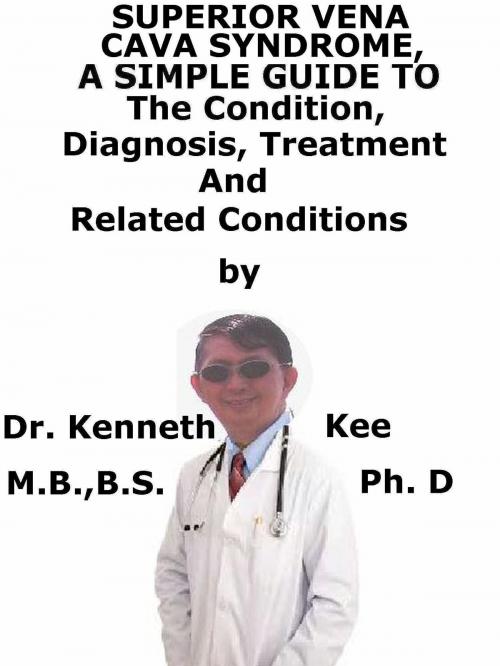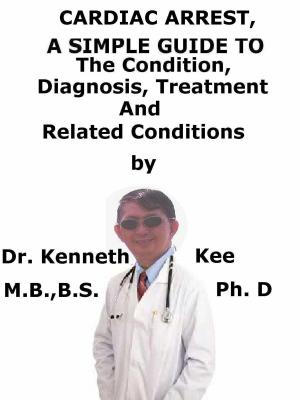Superior Vena Cava Syndrome, A Simple Guide To The Condition, Diagnosis, Treatment And Related Conditions
Nonfiction, Health & Well Being, Medical, Specialties, Internal Medicine, Cardiology, Health, Ailments & Diseases, Heart| Author: | Kenneth Kee | ISBN: | 9780463322529 |
| Publisher: | Kenneth Kee | Publication: | April 30, 2018 |
| Imprint: | Smashwords Edition | Language: | English |
| Author: | Kenneth Kee |
| ISBN: | 9780463322529 |
| Publisher: | Kenneth Kee |
| Publication: | April 30, 2018 |
| Imprint: | Smashwords Edition |
| Language: | English |
This book describes Superior Vena Cava Syndrome, Diagnosis and Treatment and Related Diseases
SVC syndrome is a constriction or obstruction of the superior vena cava (SVC), which is the second largest vein in the human body.
The superior vena cava transports blood from the upper half of the body to the heart.
Blockage of the superior vena cava (SVC) can be due to external pressure, involvement of the vessel by tumor tissue, or a blood clot blocking the lumen.
Causes
SVC syndrome is an infrequent disorder.
It is most often produced by cancer or a tumor in the mediastinum
Today, the most frequent cause is superior mediastinal pressure linked with lung cancer (> 85%).
SVC syndrome can also be produced by non-cancerous disorders that produce scarring.
1.Histoplasmosis (fungal infection)
2.Inflammation of a vein (thrombophlebitis)
3.Lung infections (such as TB)
Other causes of SVC blockage are:
1.Aortic aneurysm (a widening of the artery that leaves the heart)
2.Blood clots in the SVC
3.Constrictive pericarditis (tightening of the thin lining of the sac surrounding the heart)
4.Effects of radiation therapy for certain medical conditions
5.Enlargement of the thyroid gland (goiter)
6.Catheters placed in the large veins of the upper arm and neck
Symptoms
Symptoms may start suddenly or gradually, and may worsen when the patient bends over or lies down.
1.Swelling around the eye
2.Swelling of the face
3.Swelling of the whites of the eyes
The swelling tend most likely be worse in the early morning hours and fade away by mid-morning.
The most frequent symptoms are shortness of breath (dyspnea) and swelling of the face, neck, trunk, and arms.
In adults, bronchogenic carcinoma was the most frequent cause of SVC obstruction
In children, the most frequent causes are T-cell acute lymphoblastic leukemia and non-Hodgkin's lymphoma
Other probable symptoms are:
1.Decreased alertness
2.Dizziness, fainting
3.Headache
4.Reddish face or cheeks
Signs:
1.Dilated veins over the arms, neck and anterior chest wall.
2.Edema of the upper body, extremities and face.
3.Severe respiratory distress.
Diagnosis
The doctor will do a physical examination, which may reveal enlarged veins of the face, neck, and upper chest.
Blood pressure is often elevated in the arms and low in the legs.
CXR, CT scan and MRI: may show a widened mediastinum or a mass on the right side of the chest
Bronchoscopy has a reported diagnostic result of >70%, whilst mediastinoscopy or mediastinotomy has a result of >90%.
Treatment
The purpose of treatment is to alleviate the obstruction.
The placement of a stent (tube placed inside a blood vessel) to open up the SVC
Medical
1.Elevation of the head, and oxygen
2.Diuretics (water pills) or steroids (anti-inflammatory drugs)
3.Radiation or chemotherapy or surgery to reduce the tumor
4.Anticoagulation may be needed where venography has revealed central vein thrombosis, to prevent pulmonary embolism
Surgical
Stenting and angioplasty (also known as endovascular surgery) are particularly useful in patients requiring long-term venous access
Reconstructive surgery is possible and may be helped by the use of autologous tissue
These treatments may be used for SVCS in children:
1.Radiation therapy if a tumor is blocking the vein
2.Corticosteroids to reduce swelling
3.Chemotherapy for treatment of tumor
4 Stent placement to improve blood flow
5.Surgery so blood can flow around the blocked part of the vein
Stenting should be considered first-line treatment for SVCS of benign origin, with open surgical reconstruction still a good choice if endovascular repair fails or is unsuitable
TABLE OF CONTENT
Introduction
Chapter 1 Superior Vena Cava Syndrome
Chapter 2 Causes
Chapter 3 Symptoms
Chapter 4 Diagnosis
Chapter 5 Treatment
Chapter 6 Prognosis
Chapter 7 Mediastinal Tumors
Chapter 8 Lung Cancer
Epilogue
This book describes Superior Vena Cava Syndrome, Diagnosis and Treatment and Related Diseases
SVC syndrome is a constriction or obstruction of the superior vena cava (SVC), which is the second largest vein in the human body.
The superior vena cava transports blood from the upper half of the body to the heart.
Blockage of the superior vena cava (SVC) can be due to external pressure, involvement of the vessel by tumor tissue, or a blood clot blocking the lumen.
Causes
SVC syndrome is an infrequent disorder.
It is most often produced by cancer or a tumor in the mediastinum
Today, the most frequent cause is superior mediastinal pressure linked with lung cancer (> 85%).
SVC syndrome can also be produced by non-cancerous disorders that produce scarring.
1.Histoplasmosis (fungal infection)
2.Inflammation of a vein (thrombophlebitis)
3.Lung infections (such as TB)
Other causes of SVC blockage are:
1.Aortic aneurysm (a widening of the artery that leaves the heart)
2.Blood clots in the SVC
3.Constrictive pericarditis (tightening of the thin lining of the sac surrounding the heart)
4.Effects of radiation therapy for certain medical conditions
5.Enlargement of the thyroid gland (goiter)
6.Catheters placed in the large veins of the upper arm and neck
Symptoms
Symptoms may start suddenly or gradually, and may worsen when the patient bends over or lies down.
1.Swelling around the eye
2.Swelling of the face
3.Swelling of the whites of the eyes
The swelling tend most likely be worse in the early morning hours and fade away by mid-morning.
The most frequent symptoms are shortness of breath (dyspnea) and swelling of the face, neck, trunk, and arms.
In adults, bronchogenic carcinoma was the most frequent cause of SVC obstruction
In children, the most frequent causes are T-cell acute lymphoblastic leukemia and non-Hodgkin's lymphoma
Other probable symptoms are:
1.Decreased alertness
2.Dizziness, fainting
3.Headache
4.Reddish face or cheeks
Signs:
1.Dilated veins over the arms, neck and anterior chest wall.
2.Edema of the upper body, extremities and face.
3.Severe respiratory distress.
Diagnosis
The doctor will do a physical examination, which may reveal enlarged veins of the face, neck, and upper chest.
Blood pressure is often elevated in the arms and low in the legs.
CXR, CT scan and MRI: may show a widened mediastinum or a mass on the right side of the chest
Bronchoscopy has a reported diagnostic result of >70%, whilst mediastinoscopy or mediastinotomy has a result of >90%.
Treatment
The purpose of treatment is to alleviate the obstruction.
The placement of a stent (tube placed inside a blood vessel) to open up the SVC
Medical
1.Elevation of the head, and oxygen
2.Diuretics (water pills) or steroids (anti-inflammatory drugs)
3.Radiation or chemotherapy or surgery to reduce the tumor
4.Anticoagulation may be needed where venography has revealed central vein thrombosis, to prevent pulmonary embolism
Surgical
Stenting and angioplasty (also known as endovascular surgery) are particularly useful in patients requiring long-term venous access
Reconstructive surgery is possible and may be helped by the use of autologous tissue
These treatments may be used for SVCS in children:
1.Radiation therapy if a tumor is blocking the vein
2.Corticosteroids to reduce swelling
3.Chemotherapy for treatment of tumor
4 Stent placement to improve blood flow
5.Surgery so blood can flow around the blocked part of the vein
Stenting should be considered first-line treatment for SVCS of benign origin, with open surgical reconstruction still a good choice if endovascular repair fails or is unsuitable
TABLE OF CONTENT
Introduction
Chapter 1 Superior Vena Cava Syndrome
Chapter 2 Causes
Chapter 3 Symptoms
Chapter 4 Diagnosis
Chapter 5 Treatment
Chapter 6 Prognosis
Chapter 7 Mediastinal Tumors
Chapter 8 Lung Cancer
Epilogue















